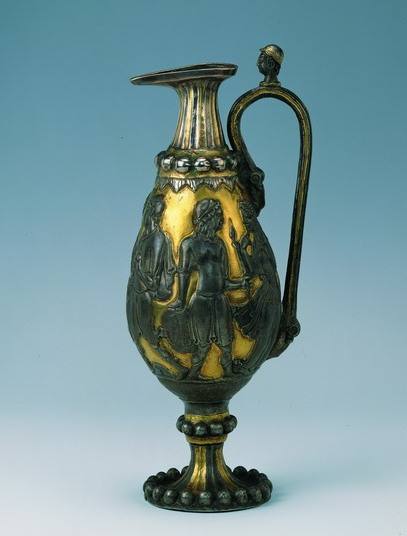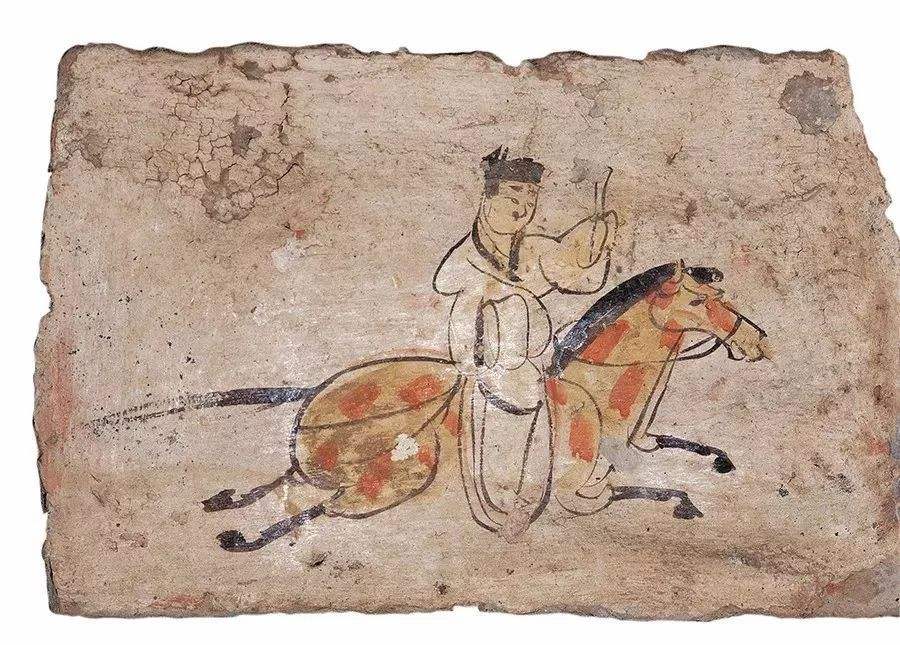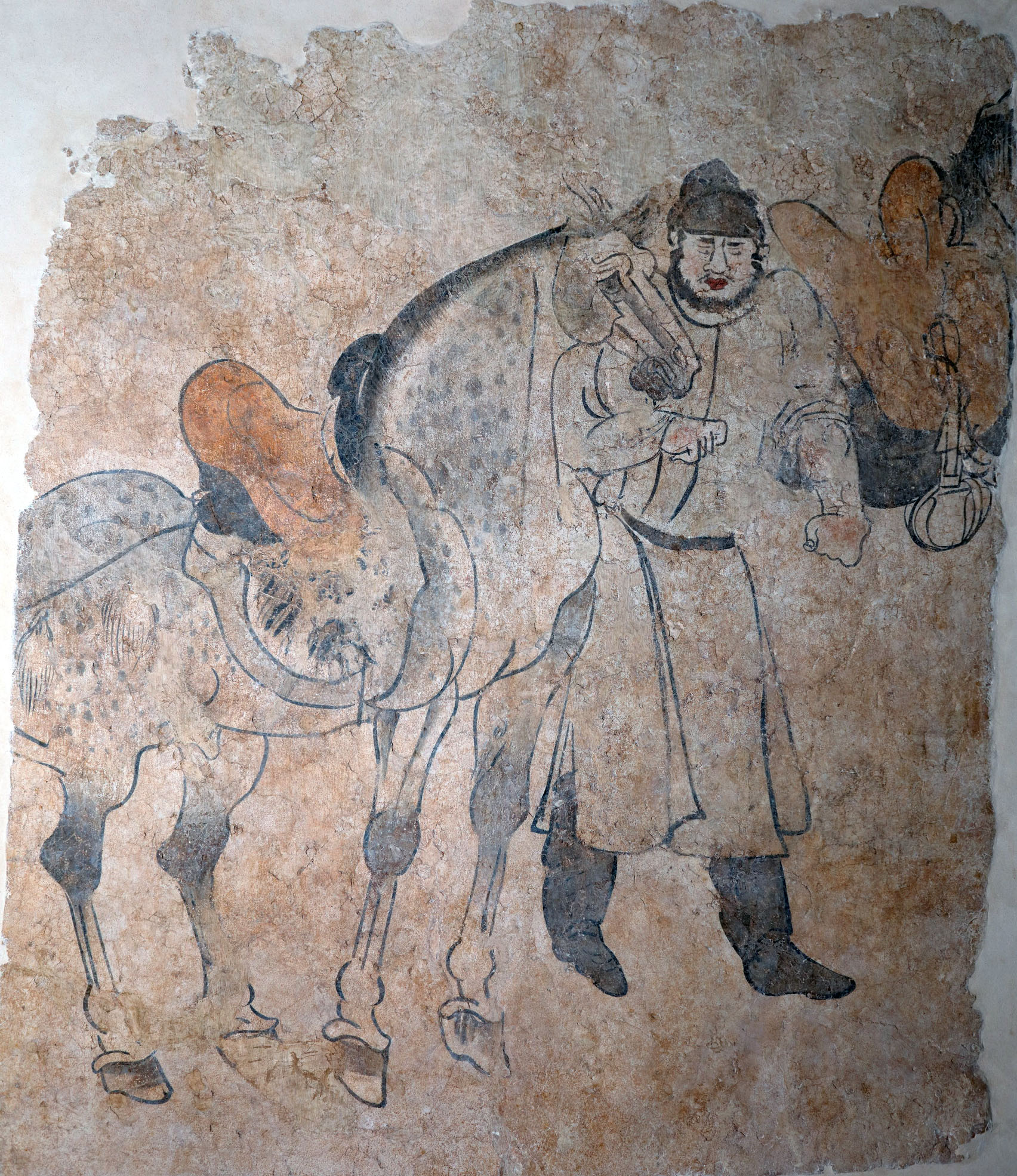DepthReading
Sino-Western Exchanges Before the Formation of the Silk Road
Summary: It is still controversy in the academic world, whether the humanbeings on earth come from Africa, or each continent has theirorigins. However, one thing is certain: before the emergence ofthe national system, humans did not need passports, visas, andh a d
It is still controversy in the academic world, whether the human
beings on earth come from Africa, or each continent has their
origins. However, one thing is certain: before the emergence of
the national system, humans did not need passports, visas, and
h a d e x p e r i e n c e d e x t e n s i v e e t h n i c m i g r a t i o n s . T h e
Indo-European-speaking Tocharians who migrated eastward from
Caspian Sea and Black Sea to Tarim Basin are one of the
representative ethnic groups in this great migration. The Kermuqi
culture between the Altai Mountains and the Tianshan Mountains
(Kermuqi in Altay, Xinjiang) is closely related to the Yamnaya
Culture on the northern coast of the Caspian Sea and the Black
Sea. The Yuezhi people (Tocharians) with Indo-European
lineage, who later ruled Hexi Corridor , probably were the
inheritors of this culture from the West to the East.
In short, during the distant ancient times, the Far East and th e
vast Western regions had communications.
Cultural fusion of the Western Regions
The so-called "Western Region" is usually a general term for the
vast areas to the west of Yang Pass and Yumen Pass, but the
connotation of this concept can be both narrow and broad. “The
Western Regions" in different historical periods refers to various
geographic ranges. Moreover, “the Western Regions” is not just a
geographical concept, also a political one.
The Western Regions of the Han Dynasty refer to the north and
south of the Tianshan Mountains and the east of Congling
(Pamirs), which is the land governed by protectorate of the
Western Regions. According to The Traditions of the Western
Regions in Book of Han, it is roughly equivalent to the south of
the Tianshan Mountains, the Tarim Basin and its surrounding
areas in Xinjiang.
In addition to the above r egions, “the Western Regions” in the
broad sense includes Central Asia, India, the Iranian Plateau, the
Arabian Peninsula, Asia Minor and even the further West. In fact,
it refers to the entire Western world known at the time.
Comparing the concept of "the Western Regions" in the Han and
Tang Dynasties, we can better find that “the Western Regions” is
a geographically changing range. With the expansion of the Tang
Dynasty's forces to Central and W est Asia, from “the Western
Regions" of the Han Dynasty to the two jurisdictions
administrated by protectorate of the Western Regions, Anxi and
Beiting. It has become the "inland" of the Tang Dynasty as the
implementation of the county system and the adoption of the
management policy consistent with the Central Plains. “The
Western Regions” was used to refer to the area beyond Anxi and
Beiting where the Tang Dynasty established the Fuzhou
Prefecture, specifically Transoxiana (between the Amu Darya and
the Syr Darya) in Central Asia, Western and Southern Asia to the
south of the Amu Darya.The Amu River is called Weishui in
The Records of the Grand Historian and Book of Han, and
Wuhuhe (phonetic translation of Ancient Greek) in Old and
New Book of Tang. The Syr River is called Yaoshashui
(phonetic translation of Ancient Persian) in Chinese historical
materials. The Amu Darya and the Syr Darya area, between
the Mongolian and the southern Russian steppes, centering
on the Fergana Basin, the Tashkent region, the Khwārazm
Delta, the upper Yenisei River, and the upper reaches of the
Irtysh River, is the ideal living habitat for ancient nomads.
The Western Regions in the broad sense of the Tang Dynasty
and the Western Regions in the narrow sense of the Han
Dynasty have the same political and military functions as the
screens of the Central Plains. In the military struggle between
the Han and the Xiongnu, as well as in the conflict of interest
between the Tang Dynasty and the Arabs, “the W estern
Regions” of each era indeed played a buffering role. The concept
of the Western Regions in the broad sense of the Tang
Dynasty was expanded compared with the Western Regions
of the Han Dynasty: with the deepening of the understanding
of the western world at that time, it expanded to the Mediterranean
coast.
“The Western Regions” today usually refers to the concept of
the Western Regions in the narrow sense of the Western and
Eastern Han Dynasties. In the Han Dynasties, the region was
multi-ethnic, multi-lingual, with diverse tribes. The government
of Han Dynasties did not change the political structure of the
region, although they established local protectorates and the
main purpose was to ensure the smooth flow of the Silk
Road.
Geographically, the narrow Western regions, the Tarim Basin,
is in the middle of Asia which was vividly called by the British
scholar Stein as "Innermost Asia". It is surrounded by mountains,
and Stein defined it as the “blocking” of the connections
between the several ancient civilizational regions. However,
this natural barrier does not completely isolate the w orld
around it. Some of the trans-mountain imports and exports
allow it to maintain its connection with the world around it and
to take advantage of the natural situation to avoid complete
assimilation.
Therefore, “the Western Regions” is actually the converging
point of worldwide civ ilizations, the Pers ian civilization,
ancient Greek and Roman civilization, Indian civilization and
Chinese civilization gathering here. While fully absorbing
these civilizations, the Western Regions have not been swallowed
up by the torrents of these cultures but have digested
and absorbed by themselves to form a unique culture that is
suitable for the characteristics of the region. Here you can
find the shadow of many ancient cultures, and also feel the
uniqueness of Western Region culture. This is the charm of
Western Region culture.
Northern Steppe Road
Cultural exchanges between China and the W est existed in
ancient times before silk became a major commodity.
The emergence of the Steppe Road and the Oasis Road is the
concrete manifestation of this exchange. They are the predecessors
of the Silk Road. Let me talk about the Steppe Road at first.
“The Steppe Road “usually refers to the route originating from the
northern part of China to the Kazakh steppe in the northern Central
Asia via the Mongolian Plateau over the Altai Mountains and
the Junggar Basin, and then to the Danube River via the northern
shore of the Caspian Sea and the northern shore of the Black
Sea. Ancient nomads often used this passage to migrate. The
Scythians from the Indo-European ethnic group in Eastern
Europe, the Cy priots and the Da Yuezhi people in the Han -
Dynasty literature, along this route from west to east in 2000 BCE
and then going southwards to India, or northeastward to the Altai
area.
The literature of Shang Dynasty shows the existence of the
Steppe Road from another direction. Before the establishment of
Shang Dynasty, the migration of the ancestors was very frequent.
Since then, in the process of national consolidation and territorial
expansion of Shang Dynasty, there were frequent wars with the
northern minorities, prompting them to migrate to the further
north. Therefore, many ancient peoples on the northern border of
China were active in the Steppe Road for a long time. Together
with the Scythians, they have drawn a colorful picture of the flow
of civilization on Steppe Road.
Archaeological discoveries have also enriched the historical
evidence of Chinese and W estern cultural exchanges on the
Steppe Silk Road. The white jade ring unearthed in the tombs of
Glazkovo Culture discovered in the Siberian region of Russia is
clearly related to the popular white jade ring and white jade d isc
(with hole in center) in Shang Dynasty. The shape is similar to
that of the Shang Dynasty jade, as well as the ornamentation with
several circles of concentric circles. Bronze wares such as scimitars,
daggers, bows, ornaments and their animal ornaments
unearthed from the Karasuk Culture site (1200-700 BCE) also
have a certain connection with the bronze wares of Shang
Dynasty. Some scholars hence believe that the emergence of
Karasuk bronze culture is the result of the northern Chinese
immigrants bringing Chinese bronzes into the Yenisei valley. This
incident occurred around 1500 BCE, in Chinese Shang Dynasty.
The pottery tripods discovered from the Karasuk cultural site
have exactly the same shape as those in the Anyang culture.
At the same time, some bronze cultures in the outside world,
such as the Seima culture (14th -8th century BCE) around the
Volga and Oka River Valleys, which were slightly earlier than the
Anyang civilization also had an impact on the Chi nese bronze
culture. It is expressed in the shape of white jade ring, curve d
knife, axe, prismatic spear and other weapons and tools. The
medium of communication between Seima culture and Anyang
culture should be Karasuk culture. In general, however , the
superb level of the bronze culture of the Shang Dynasty has
made its influence on the K arasuk culture far more than the
Seima cultural factor it absorbed through the Karasuk culture.
Oasis Road / Jade Road
“Oasis Road” refers to the route that is located in the southern
part of the Steppe Road and is developed by the oasis city-states
in the vast desert and Gobi. It is connected by sections of roa ds
linking the oases and mountain passes allowing across the
mountains. This road has gradually become a traffic artery
between Europe and Asia. It is said that King Mu of Zhou’ s
Western Tour had followed this route. Although King Mu’ s
story of seeing the Queen Mother of the West is not necessarily
true, archaeological discoveries have traced the
appearance of this route to a period far before King Mu of
Zhou.
The archaeological finds of many years show that the jade
ware of the Central Plains of China has at least 7,000 years
of history. They are almost nephrite. So far, China's nephrite
production area is mainly in Hotan, Xinjiang, except for Fengtian
area in Hualian, Taiwan. In recent years, the Shimao
culture discovered in Shenmu, Shaanxi Province, a large
number of jade artifacts were unearthed in the ancient city of
Shimao, which is almost a jade city, and there are quite a few
jade from the west.
According to the pre-Qin literatures such as Guanzi, Classics
of Mountains and Seas, The Story of King Mu the Son of
Heaven, the jade used in the ancient Central Plains were
mostly from Hotan and Kunlun Mountains. Hotan jade indeed
accounts for the majority of the Anyang jade of S hang
Dynasty unearthed, which gives material evidence of the
records of the pre-Qin history. In the first half of the 5th cen -
tury BC, the development of the Qin State to the west began
to pause. The emerging Zhao State conquered some tribes in
the northwestern part of Shanxi, might have contact with the
Yuezhi people whose power eastw ards reached Hetao, so
the jade produced in the Altai Mountains were brought into
Zhao State continuously. (Hereditary House of Zhao, Records
of the Grand Historian). The passage of Hotan jade and Altai
jade to the Central Plains is undoubtedly the "Oasis Road".
According to the important items conveyed in the pre-Qin
periods, it can also be called the "Jade Road".
The emergence of early Sino-Western traffic was the result of the
joint efforts of the Western and Eastern people. Before Zhangqian,
textiles and bamboo products from Sichuan could be transported
from India to Afghanistan which took long time and high
price of the merchants and customers including life. However, the
war and expansion actions of several great empires in the Axial
Age, as official acts, can promote the bi-directional opening of the
East and West routes in a relatively short period of time.
Impact of expansions
In 550 BCE, Cyrus established the Achaemenid Dynasty. During
the Darius I (521- 485 BCE), the territory of the Persian Empir e
began from northwest of India and Sogdiana in the east, Egypt
and the Black Sea in the west, and the northeastern frontier had
bordered the Scythian nomadic area to the west of the Pamir .
The Persian Empire attached great importance to the construc -
tion and maintenance of the roads. It built a network of post road
connecting Central Asia, Mesopotamia, Asia Minor, Syria and
Egypt, centered on the four capitals of the Empire. The most
important and longest o f the main r oads to the w est was the
“royal road” from the ancient capital of Susa to the Ephesus ci ty
of Asia Minor, which was 2,400 kilometers long with stations and
commercial halls every 20 kilometers. There were also hostels for
overnight travelers, fast horses provided by stations, special
envoys for the delivery of of ficial documents. Urgent ones can
change horses at the station, day and night, and the entire jou rney
should be completed in seven days. Therefore, the Persian
emperor boasted that he could eat the fresh fish caught in the
Mediterranean in the Susa Palace, much faster than that Yang
Yuhuan in Chang'an received the fresh lychee from Fuling. This
complete road network also extended to the eastern part of the
empire. The main trunk line started from Babylon, traversed the
Iranian plateau, and passed through the cities of Central Asia and
reached Daxia (The Western literature refers to Bactria, south of
the Amu Darya, Northern Afghanistan) on the imperial border and
Northwest India.
During the period of the Alexander Empire (336-323BCE), the
Eurasian transportation network was further expanded. Alexander's
army striker had reached the Sogdian region between the
Amu (Oxus, also known as the W uhu River) and the Syr River
(Yoshashui). Every time the Greeks arrived, they built a stone
city, and Alexander was said to have built more than 70 new
cities in the name of "Alexanderia" on the vast eastern land from
Daxia to Egypt. More than forty archaeological attested cities
spread from the Mediterranean coast eastwards to the Afghan
and Indian borders. The Greeks brought a Hellenistic era to the
Central Asian region, and Greek culture and art were thus introduced
into Xinjiang region such as the Tarim Basin. After Zhangqian
in the Western Han Dynasty opened the route to the Western
Regions and there established the commercial road from the
Central Plains through Xinjiang to Daxia, the main trunk line i n
the original route network of Central Asia became the western
section of the Silk Roads. Even before this, this route network
undoubtedly provided convenience for the silk textiles transported
from the Central Plains to continue to spread westwards.
From the Shang and Zhou dynasties to the Spring and Autumn
Period, the attack of the Central Plains countries on the surrounding
tribes and the resulting ethnic migrations also promoted th e
development of the road. During the period of King Mu, he
changed King Zhao ’ s policy of military expansion in the southwest,
and on the large scale attacked Xirong Guifang to force the
people to migrate to the northern steppes. In the second half
of the 7th century BCE, Duke Mu of Qin expelled Jiuzhourong
which was probably the first event to have an impact on the
eastern part of Central Asia, leading to the great migration of
the Central Asian nations. The Scythians in the Westerners
literature are said to be the Jiuzhourong in the Chinese historical
materials. They moved from the northeast to the southwest
and in 612 BCE, they broke through the Assyrian capital.
It was only a dozen years away from Duke Mu’s event.
It can be seen that before Zhang Qian’ s missions to the Western
Regions, the exchanges between the Central Plains and
the Western Regions have been widespread for various reasons.
The Zhangqian Mission sent by Emperor Wu of the Han
Dynasty only provided an opportunity to officially uncover the
secret veil not widely known, changing the route of Eastern
and Western cultural communication into an of ficially dominated
one.
Category: English
DepthReading
Key words:



